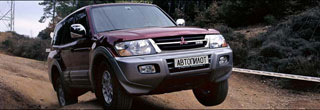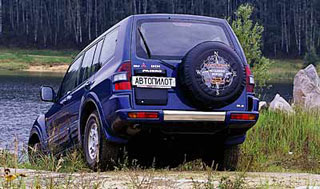Test drive Mitsubishi Pajero (Montero, Shogun) LWB 2000 - 2003 SUV
The wisdom of mature age
 The annual cosmetic update of the lineup is a long tradition of Japanese firms, including Mitsubishi. This year is not an exception, especially since the popular Pajero model celebrates the twenty anniversary. This was a good occasion to give the all-terrain vehicle Pajero in the 2003 model year new features designed to make it even more noticeable. The style of the front and rear bumpers, lanterns, chrome emblems and lining of the radiator grille have changed. In the cabin, new wood inserts with a changed color and texture of the material, combined (wood-leather) steering wheel. In general, the car has become even more luxurious.
The annual cosmetic update of the lineup is a long tradition of Japanese firms, including Mitsubishi. This year is not an exception, especially since the popular Pajero model celebrates the twenty anniversary. This was a good occasion to give the all-terrain vehicle Pajero in the 2003 model year new features designed to make it even more noticeable. The style of the front and rear bumpers, lanterns, chrome emblems and lining of the radiator grille have changed. In the cabin, new wood inserts with a changed color and texture of the material, combined (wood-leather) steering wheel. In general, the car has become even more luxurious. And yet, perhaps, this is not the main thing. Following the wise electronics that facilitates the life of the driver, the new Pajero has acquired an integrated complex consisting of three subsystems: exchange stability, control of traction and braking during descent. The first is MASC (Mitsubishi Active Stability Control) is responsible for active security. Its task is to analyze the readings of the angle of the angle of rotation of the steering wheel, controlled wheels, the speed of the car and the position of the body, recognize the beginning of the skid and adjust it. The second - MATC (Active Stability Control) increases cross -country ability, increasing the torque on the most loaded wheels. Finally, the MEBAC (Engine Brake Assist Control) helps to keep the car in the conditions of off -road descent. A single whole is united by the fact that they, using the working brake system, either slow down a separate wheel, adjusting the sliding occurring, or take on the role of a differential lock, redistributing the torque. The essence of the last subsystem is that, maintaining the constant speed of the descent, it similarly redistributes the brake moment created by the engine.
Naturally, all this could not be tried.
On the asphalt
 Short -boring Mitsubishi Pajero, and even with a gasoline 3.5 -liter engine - the car is very frisky, provoking fast, dynamic driving. It is quite natural that in comparison with a longer and more calm brow, this is much more critical to the driver’s mistakes and in the extreme situation can arrange not only the impulsive skidding of the rear axle, but also subsequent fluctuations when trying to compensate for it. Therefore, our experiment is not difficult, since the course of the course stability can be turned off. A grader path with a set of turns makes it easy to reach speeds at which powerful tires begin to slip almost like in winter - it's time to evaluate the performance of an electronic assistant.
Short -boring Mitsubishi Pajero, and even with a gasoline 3.5 -liter engine - the car is very frisky, provoking fast, dynamic driving. It is quite natural that in comparison with a longer and more calm brow, this is much more critical to the driver’s mistakes and in the extreme situation can arrange not only the impulsive skidding of the rear axle, but also subsequent fluctuations when trying to compensate for it. Therefore, our experiment is not difficult, since the course of the course stability can be turned off. A grader path with a set of turns makes it easy to reach speeds at which powerful tires begin to slip almost like in winter - it's time to evaluate the performance of an electronic assistant. In the first turn, such a desired skid begins, but as soon as the driver is ready to take countermeasures, a barely audible chirping is heard in the bowels of the car, accompanied by a light stranging of the motor: as if an invisible hand erects a car, returning it to a given trajectory. It seems that the electronics passed the exam, - turning off the stabilization system, I amused my own ambitions, but I also worked as a steering wheel. Of course, the help of electronics is not for all occasions, but she can serve a good service in an inexperienced dashing.
On the off -road
 Spring thaw is already behind; Maybe this is for the better: our rides is the most standard and risk of stagnation in the mud is quite large. And so the combination of ditches, rise and descents will allow you to quite effectively load the transmission, forcing the electronics to work. To begin with, I try to overcome a rather steep slide right in this way, in the rear -wheel drive version.
Spring thaw is already behind; Maybe this is for the better: our rides is the most standard and risk of stagnation in the mud is quite large. And so the combination of ditches, rise and descents will allow you to quite effectively load the transmission, forcing the electronics to work. To begin with, I try to overcome a rather steep slide right in this way, in the rear -wheel drive version. Having quickly stalled, Pajero thinks for a split second and, under the already familiar crackling, blocks the rear differential. The effect is noticeable - the car overcomes more centimeters of thirty slopes and only then gives up: they say, it's time to turn on all -wheel drive. Well, let's recall the famous super select: I transfer the lever to position 4 HLS - and again on the attack on the slope. This time we rise noticeably higher, but again for a split second we hang in a difficult place ... And suddenly, under the saving crackling of electronics, we easily enter upstairs! Not bad. Now the diagonal hanging in a targeted ditch, where the all -around, very clearly slowed down the wheels hanging in the air and redistributing the torque, quickly goes on. Only the danger to tear off the front bumper holds from the desire to repeat the experiment in an even deeper trench.
To demonstrate the last advantage of electronics, you need a long steep descent, and even with a crossed profile. Alas, this was not found for the test, and in less loaded areas the car behaves quite worthy. Nevertheless, I think that this subsystem would have worked flawlessly.
To help non -professionals
 Obviously, the number of all kinds of auxiliary systems in the car will only increase. All -terrain vehicles here are no exception. However, most of these jeepers relate to innovations skeptical, preferring proven mechanics. Why? Partly the answer to this question is given by Mitsubishi specialists. Based on their vast experience, they emphasize that the integrated MASC+MATC+MEBAC system cannot completely replace the traditional all -wheel drive scheme with a forced blocking of differentials. It only increases active safety and simplifies the driving of an off -road, and even then in certain conditions. That is, a person who is far from all -resistant raids and bang, helping electronics for the good, with her he will be able to get out of a non -standard situation. Well, for those who are confident in their own abilities and do not trust electronic deeds, it was decided so far to preserve the usual all -wheel drive with mechanical locking of the rear differential. So both versions of the car will be present on the market, and only the most expensive Pajero configurations will be given to electronics.
Obviously, the number of all kinds of auxiliary systems in the car will only increase. All -terrain vehicles here are no exception. However, most of these jeepers relate to innovations skeptical, preferring proven mechanics. Why? Partly the answer to this question is given by Mitsubishi specialists. Based on their vast experience, they emphasize that the integrated MASC+MATC+MEBAC system cannot completely replace the traditional all -wheel drive scheme with a forced blocking of differentials. It only increases active safety and simplifies the driving of an off -road, and even then in certain conditions. That is, a person who is far from all -resistant raids and bang, helping electronics for the good, with her he will be able to get out of a non -standard situation. Well, for those who are confident in their own abilities and do not trust electronic deeds, it was decided so far to preserve the usual all -wheel drive with mechanical locking of the rear differential. So both versions of the car will be present on the market, and only the most expensive Pajero configurations will be given to electronics. The combination of skin, wood and off -road paraphernalia is characteristic of a modern all -terrain vehicle.
Learning ... Excuse me, Pajero's capabilities by immersion.
The slippery grader was perfect for assessing the course stability system.
Behind in a short -packing Pajero is quite spacious, but getting there is difficult to get there.


Sergey Voskresensky
Photo: George Sadkov
Source: The magazine "Driving"
Mitsubishi Pajero (Montero, Shogun) LWB 2000 - 2003
Mitsubishi Pajero (Montero, Shogun) LWB 2000 - 2003
Mitsubishi Pajero Faults 5 doors: Detailed information| Pajero (Montero, Shogun) LWB 2000 - 2003 | |
|---|---|
| Engine |  |
| Transmission |  |
| Control system and suspension |  |
| Brake system |  |
| Air heating and air conditioning |  |
| Launch and charging system |  |
| Electric components and so on |  |
| Corrosion body stability |








